Exploring the wonders of Namhae County
IN CELEBRATION of the Chu-seok holidays, my family went down to my father’s hometown, Namhae county. Namhae, although not as well known as other regions like Busan and Gyeong-ju, is an island rich in culture and history. Located in the southwestern region of Gyeongsangnam-do, it is known for its tranquil atmosphere and stunning views. While there are multiple ways to get to Namhae from Seoul, the most convenient is via plane—from Gimpo to Sacheon; it is recommended that you rent a car to drive from the airport to Namhae-gun. During my trip, I visited the most well-known tourist sites which include the exotic Namhae German Village, Da-rang-yi Village with its distinct terraced fields, and the renowned Bo-ri-am Temple.
A German sanctuary in Namhae
My first stop was the Namhae German Village, a residential area famous for its German-style houses. During the 1960s and 1970s, when South Korea was facing immense economic struggles, individuals immigrated to Germany to find work as nurses and miners. Many of them, who eventually returned, resettled in Namhae during the 2000s and built houses with materials imported from Germany to recreate the familiar atmosphere of their homes back in the country, building what is now known as the “Namhae German Village.” Currently, it is one of the most popular tourist sites in Namhae due to its gorgeous scenery and opportunity to sample German culture[1].
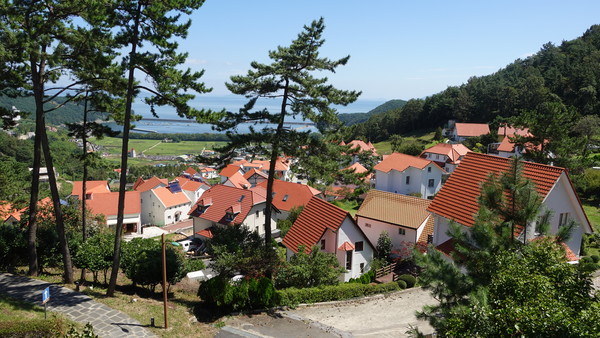
Parking and admission to the German Village are free for everyone. Near the parking lot is the entrance to Deutscher Plaza where you can buy traditional German snacks such as sausages and beer. You will also find in the plaza the Namhae German Exhibition Hall which shares the history of those who immigrated to Germany to earn their living. From the plaza, there is a small trail that leads to a viewpoint from which you can see the entire village and enjoy the breathtaking view of Namhae along with its enchanting blue sea.
As I walked down from the plaza into the main village area, I was greeted by the vibrant orange rooftops of the German houses—the color of the rooftops is a common feature in European countries as tiles were made of clay, causing the roofs to be made in shades of red and orange. Not only does the German Village allow tourists to take in the sight of these traditional houses, but they can spend a few days inside as well. Out of the 42 German houses in the village, around 30 of them are guest houses that visitors can book for a few nights’ stay. The rate ranges from ₩70,000 to ₩350,000 per night depending on the house and the season.

Throughout the village, there were banners promoting Oktoberfest, an annual German folk festival that features various events celebrating German culture[2]. The festival is held in the village every year, from the end of September to the start of October. During the festival, various beer-related activities are held, of course, as well as traditional parades and performances that you can feast your eyes on. The Oktoberfest celebration draws many visitors to the village every year and you certainly do not have to be a beer fanatic to enjoy the festivities that occur during the week!
Taking in the view at Da-rang-yi Village
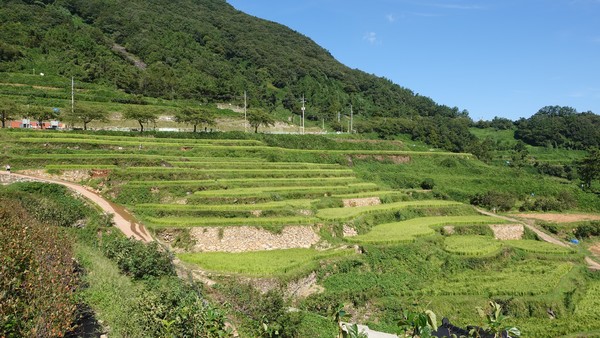
Another site that you cannot miss out when you go to Namhae is the Da-rang-yi Village. The terraced rice fields offer a captivating view that allows visitors to breathe in the fresh air of the countryside while taking picturesque shots of the scenery. This is especially the case in spring when the canola flowers are in full bloom, creating a stunning cascade of yellow blossoms on the mountain hill. Visually striking, the distinctive terraced design actually serves a utilitarian purpose as Namhae villagers had to clear a stairwell for cultivation, making full use of their small and steep plots of land.
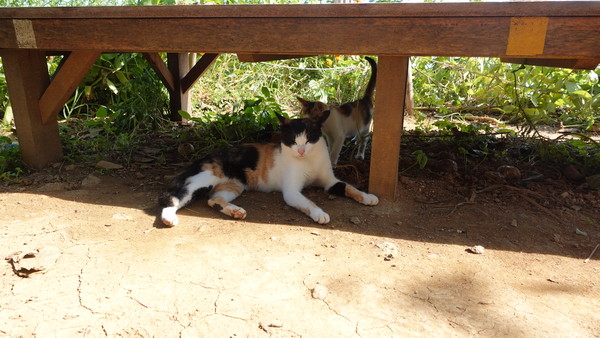
To get great photos of the fields, I had to go downhill along the neighboring houses. If you go further down towards the ocean, there are areas where visitors are able to walk between the crops to take photos surrounded by a lush green field. You can also walk through the streets of the village and see various restaurants and cafes, as well as the occasional stray cat. Despite the popularity of the area[3], Da-rang-yi Village avoids making visitors feel like they are in a tourist spot. The neighborhood has been almost untouched by development, thus maintaining the antique charm of old houses and winding streets. There was a cafe that I came across towards the bottom of the village, called Cafe Tol, which turned out to be a popular spot for visitors due to its aesthetic décor and beautiful ocean view. One of the best items on the menu was the “citron ade” as citron is one of the ingredients that Namhae County is famous for.
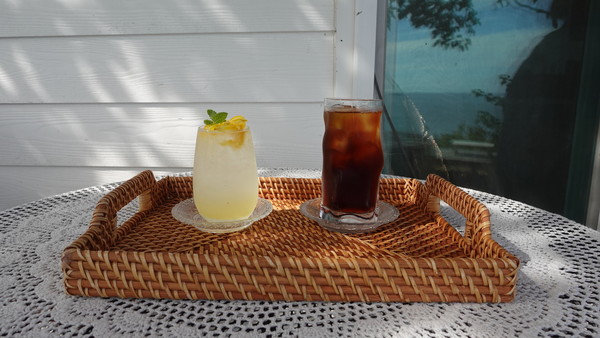
While most visitors spend the bulk of their time at the Da-rang-yi Village simply taking photos, there are other activities that they can participate in. For example, in October, groups can farm sweet potatoes for ₩8,000 per person or try their hand at net fishing for ₩15,000 per person. These activities offer visitors a chance to experience firsthand the rural lifestyle that villagers in Da-rang-yi enjoy, and the delicious reward at the end is an added bonus.
A spiritual experience at Bo-ri-am
The last place I visited was the Bo-ri-am Hermitage, one of the three great places of prayer for Gwan-eum[4]—also known as Guan-yin—in South Korea. The admission price is ₩1,000 for adults. There are two large parking lots available for visitors—one closer to the bottom of the mountain and another closer to the top. If you get there before 8 a.m., parking fees can be waived. It is recommended you go early, not only to avoid the parking fees, but also to avoid large crowds. A shuttle bus is available that can take visitors from the first parking lot to the second parking lot, for which a round-trip ticket costs ₩2,500. From the second parking lot, I only had to walk for around 10 to 15 minutes uphill to get to the top. The climb is not difficult, so people of all ages can easily walk up and experience the age-old wonders of Bo-ri-am.
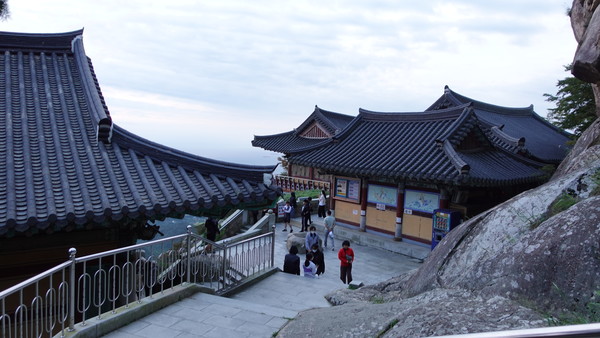
At the top, there are multiple temples and ancient statues for people to pray in and visit. The most recognizable sight would be the giant statue of Gwan-eum, located where the Gi—energy—is the strongest in the Bo-ri-am Hermitage. In front of the statue is a mat where you will most likely see visitors praying. As one of the three great places for Gwan-eum, it is said that at least one of your prayers is guaranteed to be answered.
Further up the mountain, there is a restaurant called Geum-san-san-jang where you can order a cup of instant noodles to eat in addition to other popular Korean menus such as gim-bap[5] and pa-jeon[6]. Since the picnic tables are right at the edge of the mountain, this is where you can enjoy one of the best unrestricted views of the area. Here, visitors can quietly savor their food while taking some time to truly appreciate the surrounding nature without any distractions.
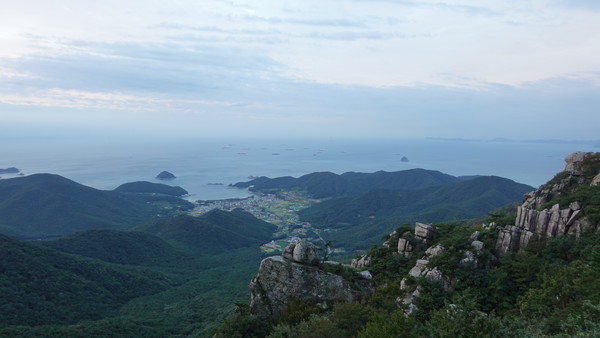
* * *
While Namhae may not be the most popular holiday destination in South Korea, there are a variety of sites to make for a meaningful one-day trip. With an abundance of culturally significant sites to visit, one can expect to have a novel experience learning about the history of the island. You can also experience for yourself the sense of peace that overcomes you when you climb up to the Bo-ri-am temple, or the comforting stillness of the Da-rang-yi neighborhood as you quietly walk through its worn-out streets. If you are looking for a quiet and serene destination to take a breather from the city life, Namhae will be the perfect place for your next trip.
[1] Namhae County
[2] Oktoberfest.de
[3] The Korea Herald
[4] Gwan-eum: The Buddhist Goddess of Mercy
[5] Gim-bap: A Korean snack made of rice and vegetables rolled in dried seaweed
[6] Pa-jeon: A Korean green onion pancake

